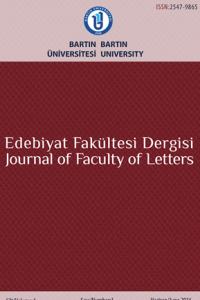YİĞİT BENER’İN ÖTEKİ KÂBUSLAR’INA PSİKANALİTİK BİR YAKLAŞIM
Yiğit Bener (b. 1958), who started to be known for his translation works in Turkish literature and his stories
published in magazines, begins publishing stories and novels after two thousand years. Besides being the son of
Erhan Bener, he draws attention to the extraordinary atmosphere he creates with the different narrative
techniques and allegories he uses in his stories. His first short story book, Öteki Kâbuslar [Other
Nightmares](2009), consists of stories constructed in fables in a way similar to social criticism by making the
“animal” figures seen in many western writers, from modernist fictions to the use of anonymous narratives, from
Geroge Orwell to Kafka.
Bener, describes society's shortcomings and wrongs, hatred, legitimization of death and ‘otherness’
through various animals. The author's autobiographical memory, powers of observation, testimonies and
experiences also refer to the formation of the stories in the work. It tries to expose problems that are not seen
or ignored by addressing both individual and social problems. The fact that the story person has psychological
depth and also the frequent use of animal figures makes it possible to evaluate within the framework of
psychoanalytic literary theory. In this study, references to the function and deep structure attached to animal
characters, emphasis on the social and individual subconscious will be revealed, and how indicators evolve into
social criticism will be discussed.
Anahtar Kelimeler:
Yiğit Bener, Öteki Kâbuslar, psikanalitik edebiyat kuramı, hayvan karakterler
A PSYCHOANALYTIC APPROACH ON YİĞİT BENER'S ÖTEKİ KÂBUSLAR (OTHER NIGHTMARKS)
Yiğit Bener (b. 1958), who started to be known for his translation works in Turkish literature and his stories
published in magazines, begins publishing stories and novels after two thousand years. Besides being the son of
Erhan Bener, he draws attention to the extraordinary atmosphere he creates with the different narrative
techniques and allegories he uses in his stories. His first short story book, Öteki Kâbuslar [Other
Nightmares](2009), consists of stories constructed in fables in a way similar to social criticism by making the
“animal” figures seen in many western writers, from modernist fictions to the use of anonymous narratives, from
Geroge Orwell to Kafka.
Bener, describes society's shortcomings and wrongs, hatred, legitimization of death and ‘otherness’
through various animals. The author's autobiographical memory, powers of observation, testimonies and
experiences also refer to the formation of the stories in the work. It tries to expose problems that are not seen
or ignored by addressing both individual and social problems. The fact that the story person has psychological
depth and also the frequent use of animal figures makes it possible to evaluate within the framework of
psychoanalytic literary theory. In this study, references to the function and deep structure attached to animal
characters, emphasis on the social and individual subconscious will be revealed, and how indicators evolve into
social criticism will be discussed.
Keywords:
Yiğit Bener, Öteki Kâbuslar, psychoanalytic literary theory,
___
- Balık, Macit (2011). “Ferit Edgü’nün Kaçkınlar’ına Psikanalitik Bir Yaklaşım”, II. Uluslararası Edebiyat ve Bilim‐I Sempozyumu, Ankara: Ankara Üniversitesi Dil ve Tarih- Coğrafya Fakültesi Yayınları, s. 201-220 Bener, Yiğit (2012). Öteki Kâbuslar. İstanbul: Can Yayınları. Budak, Ali (2009). “Psikanalitik Edebiyat Eleştirisi ve Bir Uygulama Denemesi”, Dumlupınar Üniversitesi Sosyal Bilimler Dergisi, 25, s. 13-26. Cebeci, Oğuz (2004). Psikanalitik Edebiyat Kuramı. İstanbul: İthaki Yayınları. Emre, İsmet (2009). “Yeni Türk Edebiyatının Psikolojik Kaynakları”, Turkish Studies, 4/1, s. 319-355 Freedman, J.L.-Sears, D.O,- Carlsmith, S.M. (2003). Sosyal Psikoloji. Ali Dönmez (Çev). Ankara: İmge Kitabevi Yayınları. Freud, Sigmund (1996). Düşlerin Yorumu 1 (2. Baskı). Dr. Emre Kapkın (Çev). İstanbul: Payel Yayınevi. Freud, Sigmund (2001). Sanat Ve Sanatçılar Üzerine (2. Baskı). Kâmuran Şipal (Çev). İstanbul: Yapı Kredi Yayınları. Gürel, Emet-Muter, Canan (2007). “Psikomitolojik Terimler: Psikoloji Literatüründe Mitolojinin Kullanılması”, Anadolu Üniversitesi Sosyal Bilimler Dergisi, 1, s. 537-569. Mitscherlick, Alexander (1997). “Zulüm Üstüne Savlar”, Cogito, 6-7, s. 221-236. Moran, Berna (2018). Edebiyat Kuramları ve Eleştiri (28. Baskı). İstanbul: İletişim Yayınları Özdemir, Arzu (2005). Yusuf Atılgan’ın Romanlarının Psikanalitik Açıdan İncelenmesi. Yayımlanmamış Yüksek Lisans Tezi. Elazığ: Fırat Üniversitesi Sosyal Bilimler Enstitüsü. Soylu, Özge (2001). Nahid Sırrı Örik, Kıskanmak ve Psikanaliz. Yayınlanmış Yüksek Lisans Tezi. Ankara: Bilkent Üniversitesi Ekonomi ve Sosyal Bilimler Enstitüsü. Şen, Can (2012). Edebiyat İncelemelerinde Psikanaliz Kullanımı. Ankara: Divan Kitap. Şenödeyici, Özer (2012). “Oedipus Kompleksi Bağlamında Divan Şiirinde Âşık-Maşûk-Rakîb İlişkisine Bakış”, Gazi Türkiyat Türkoloji Araştırmaları Dergisi, 11, s. 79-91. Tiken, Servet (2009). “Cahit Sıtkı Tarancı’nın Şiirlerindeki ‘Ayna’ İmgesine Psikanalitik Bir Yaklaşım”, Atatürk Üniversitesi Türkiyat Araştırmaları Enstitüsü Dergisi, 41, s. 47-60. Url-1: https://banukibar.wordpress.com/2016/08/04/otekinin-otekisinin-pesinde-yigitbener/. Erişim tarihi: 13.04.2018. Yıldız, Sibel (2014). Freudyen Psikanaliz Kuramları Işığında Balzac’ı İncelemek: Tuhaf Öyküler. Yayınlanmamış Yüksek Lisans Tezi. Erzurum: Atatürk Üniversitesi Sosyal Bilimler Enstitüsü. Yivli, Oktay (2017). “Yiğit Bener’den Böcek Öyküleri”, TÜRÜK Uluslararası Dil, Edebiyat ve Halkbilimi Araştırmaları Dergisi, 11, s. 68-76.
- ISSN: 2602-3520
- Yayın Aralığı: Yılda 2 Sayı
- Başlangıç: 2016
- Yayıncı: Bartın Üniversitesi
Sayıdaki Diğer Makaleler
İNGİLİZ KOLONİSİ KENYA´NIN BAĞIMSIZLIK MÜCADELESİ: MAU MAU HAREKETİ
BARTINLI ŞAİR HASAN BAYRI’NIN HAYATI VE EDEBÎ KİŞİLİĞİ
HAFIZLIK EĞİTİMİ ALMIŞ BİREYLERİN BENLİK SAYGISI ÜZERİNE NİTEL BİR ÇALIŞMA
SEZAİ KARAKOÇ’UN PİYESLERİNDE ANLATICI KULLANIMI ÜZERİNE BİR İNCELEME
AZERBAYCAN TÜRKÇESİNİN SÖZ VARLIĞINDA RENK ADLARI VE YÜKLENDİKLERİ ANLAMLAR
‘ABBÂS MAHMÛD EL - ‘AKKÂD’IN GÜZELLİK ANLAYIŞI
